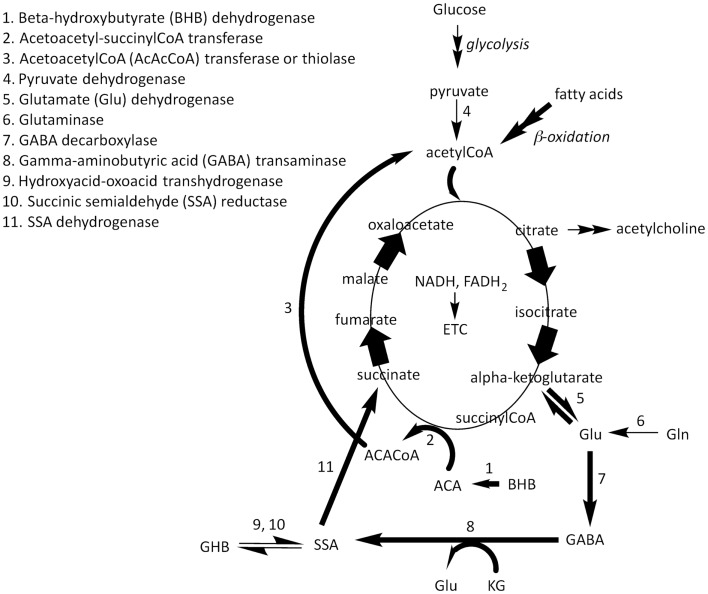Figure 1.
β-hydroxybutyrate and ACA are utilized as fuel molecules in all mitochondria-containing tissues (except liver). BHB is oxidized to ACA by β-hydroxybutyrate dehydrogenase at the inner mitochondrial membrane (arrow 1). ACA acquires the CoA moiety from succinylCoA resulting in succinate and acetoacetylCoA (ACACoA; arrow 2). ACACoA releases acetylCoA catalyzed by ACACoA thiolase (arrow 3). AcetylCoA generated from β-oxidation of fatty acids from the diet and acetylCoA generated by the catabolism of KB is condensed into citrate in the Krebs cycle. The increased flux in the right part of this cycle, increases the concentration of α-ketoglutarate (KG) resulting in increases in the production of Glu via glutamate dehydrogenase (arrow 5) or a transaminase (not shown). Glu from these reactions in addition to that formed from the deamination of glutamine (Gln) via glutaminase (arrow 6) result in the generation of γ-aminobutyric acid (GABA). The GABA shunt bypasses two steps of the Krebs cycle – the KG dehydrogenase complex and the succinyl coenzyme A (CoA) synthase – for the conversion of KG into succinate. It involves three enzymes: a Glu decarboxylase (GAD; arrow 7), which catalyzes the decarboxylation of glutamate to GABA, a GABA transaminase (arrow 8), which converts GABA to succinate semialdehyde (SSA), and an SSA dehydrogenase (arrow 11), which catalyzes the oxidation of SSA to succinate. SSA can be reduced to γ-hydroxybutyric acid (GHB) by an alternative reaction catalyzed by either a hydroxyacid–oxoacid transhydrogenase or SSA reductase (arrows 9, 10).

